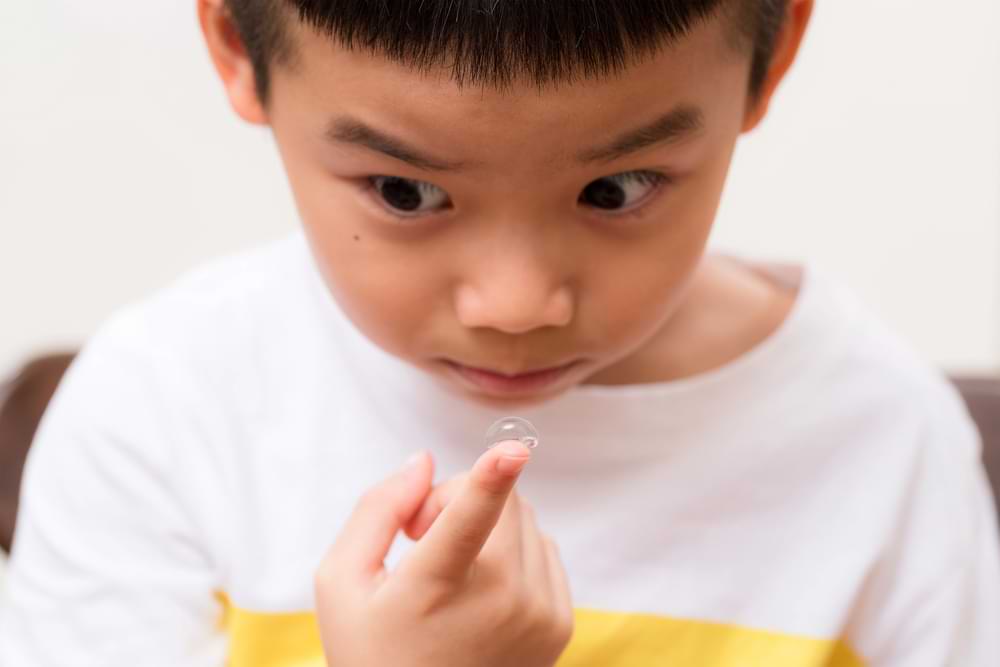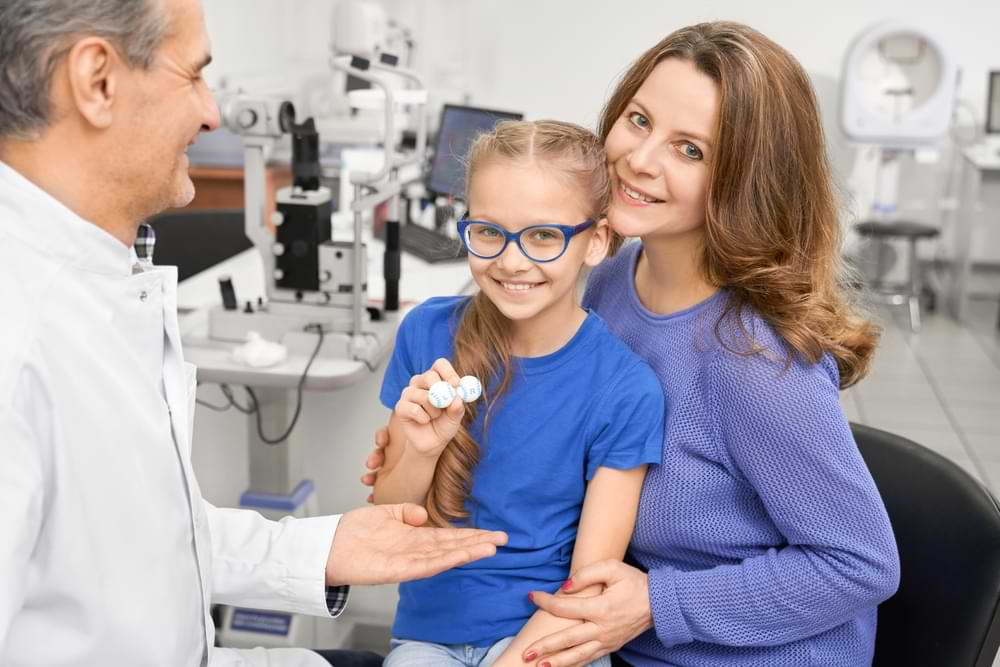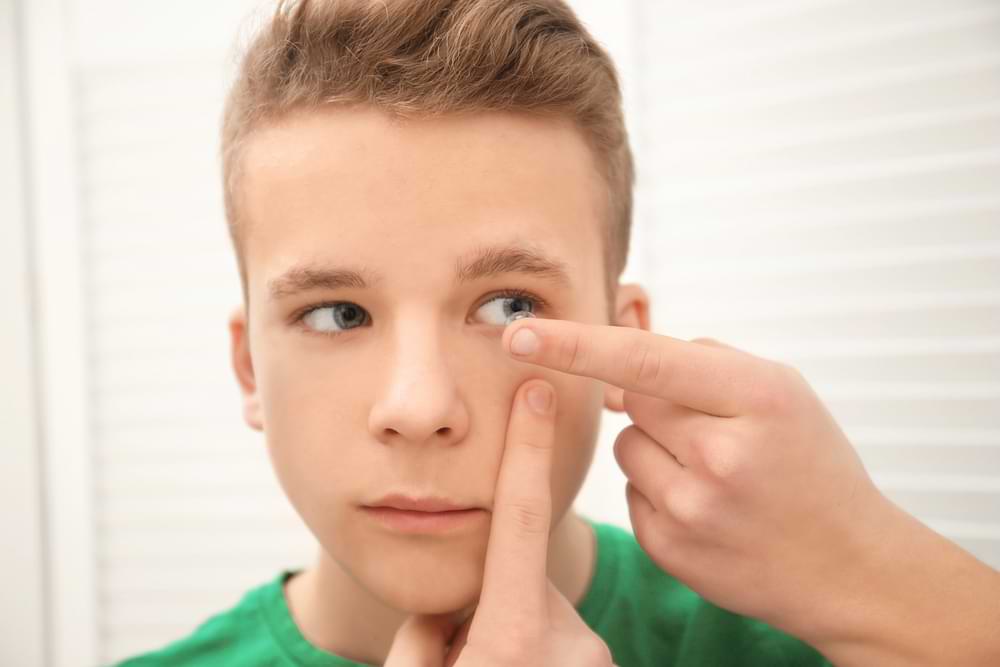Kids Contact Lenses FAQ

Many parents think contact lenses are unsafe for children or that kids are too young to handle them. The truth? With proper care, contacts are just as safe as glasses. And for some children, they’re the better option.
A US study found that 14.5% of children under 17 wear contact lenses, either for convenience or to slow myopia progression. Advances in lens technology mean children can now enjoy clear vision without glasses, while specialised lenses like MiSight and Ortho-K can help control myopia.
I’m Minh Van Tran, Principal Optometrist at VisionPro Optometrists, and I’ve assisted many families navigate their child’s vision needs. Let’s answer the most common questions about kids and contact lenses.
What Types of Contact Lenses Are Best for Kids?
Daily Disposable Contact Lenses
Single-use contact lenses are ideal for younger wearers. They are worn once and discarded.
Why choose daily disposables?
- Lower risk of infection – no need for lens cleaning
- Convenient – no cleaning or nightly disinfecting routine required
- Comfortable – fresh lenses every day without any protein deposit buildup
Myopia Control Contact Lenses
Certain contact lenses don’t just correct vision; they also help slow myopia progression. Two of the most common options are:
- MiSight 1 day lenses – FDA-approved for children aged 8-12, proven to slow myopia progression.
- Ortho-K (Orthokeratology) lenses – Worn overnight, reshape the cornea. This gives kids clear vision during the day.
Ortho-K is especially useful for kids who prefer to be free from glasses or contacts during school and sports.
Rigid Gas Permeable (RGP) Lenses
RGP lenses are known for their durability and sharp vision. This makes them a reliable choice for children with high prescriptions or irregular corneas. These lenses provide crisper vision, particularly for those with astigmatism, but they require an adaptation period.
Initial discomfort is common, but with regular wear, the eyes adjust over time. RGP lenses last longer than soft lenses, making them a cost-effective option in the long run.

Why Should I Consider Contact Lenses for My Child?
Confidence
Many children struggle with glasses, especially for sports and outdoor activities. Contact lenses provide a full field of vision, without the difficulties associated with frames.
Kids who wear contacts often feel more confident, as they don’t have to worry about glasses slipping or breaking. Peripheral vision is also improved, which is particularly important for football, basketball, and swimming, where unrestricted sight is a major advantage.
If your child feels self-conscious about their appearance with glasses, contact lenses are also worth consideration.
Myopia Control Benefits
If your child’s short-sightedness worsens every year, contact lenses like MiSight or Ortho-K can help slow the progression. Managing myopia early reduces the risk of serious eye conditions later in life, like retinal detachment, glaucoma, and macular degeneration.
Myopia treatment is more effective when intervention is taken early in life, while a child’s eyes are still developing. When they stop growing it can be too late to reverse myopic eyeball conditions. LASIK surgery in adulthood only treats the cornea (the front of the eye). It doesn’t do anything to reduce the risks of vision loss from conditions impacting the retina and other eye structures.
What Are the Pros & Cons of Contact Lenses vs. Glasses for Kids?
Contact Lenses
Pros
- Better peripheral vision – No frames blocking side vision.
- Great for sports – No risk of breakages or falling off.
- Myopia control – MiSight and Ortho-K help slow progression.
- Boosts confidence – Some kids prefer contact lenses over glasses.
- No fogging or slipping – Works in all weather conditions.
Cons
- Requires responsibility – Hygiene routines must be followed.
- Higher long-term cost – Specialised lenses can be expensive.
- Infection risk – Poor handling increases the chance of eye issues.
- Daily care needed – Even disposables require proper hygiene.
Glasses
Pros
- Easy to wear – No need for insertion, removal, or cleaning.
- Lower infection risk – No direct eye contact.
- Cost-effective – Cheaper upfront than contact lenses.
- Good for young kids – Suitable for those not ready for lenses.
Cons
- Can break or get lost – Risk of damage when the kids are at play.
- Limited side vision – Frames block the peripheral view.
- Not ideal for active kids – Can slip, fog up, or be a hassle.
- Confidence concerns – Some kids prefer not to wear glasses.
How Young Can Kids Start Wearing Contact Lenses?
Many children can start with contact lenses as early as 8 years old. There’s no strict age limit, but responsibility matters more than age. Is your child ready? Ask yourself:
- Can they follow hygiene rules independently?
- Do they complete daily tasks without reminders?
- Are they careful with their belongings?
If you’d like to learn more about whether your child is old enough for contact lenses, watch the following video from Dr. Dr. Gabriela Olivares on the VSP Vision Care YouTube Channel.
Are There Infection Risks With Contact Lenses?
Contact lenses are safe for children when used correctly, but poor hygiene can increase the risk of eye infections. Without proper care, bacteria and debris can build up on the lenses, which leads to irritation or more serious conditions like keratitis and conjunctivitis. In rare cases, improper lens use can even cause corneal ulcers, which may result in long-term vision problems.
Some children may not be suitable candidates for contact lenses, especially if they struggle with allergies, experience frequent eye infections, or have difficulty with hygiene instructions. For these children, glasses may be the better option until they can manage the responsibility of contact lens care.
What Are The Rules For Safe Contact Lens Use?
Basic Hygiene and Handling
Good hygiene is key to keeping contact lenses safe and comfortable. Kids should always wash their hands before touching lenses and use only prescribed solutions. Saliva should never be used to clean lenses, as it can introduce bacteria and increase the risk of infections.
NEVER Use Water
It’s extremely important that children understand to NEVER apply tap water on their contact lenses. All water sources (even sea water and chlorinated pool water) have the risk of carrying parasites which, when they become lodged under contact lenses, can lead to serious eye infections and even blindness. Only use saline solutions and other prescribed cleaning and storage materials.
Safe Storage and Replacement
Contact lenses must be worn and replaced as prescribed. Overwearing lenses or old lens cases increases the chance of contamination. To reduce risk, children should follow the recommended wearing schedule and replace their lens case every three months. Proper storage ensures lenses remain clean and comfortable.
Avoiding Common Mistakes
Some common mistakes can lead to eye discomfort or infections. Kids should never sleep in contact lenses unless prescribed and should always remove lenses before they swim or shower. These precautions help prevent bacteria from getting trapped between the lens and the eye, which lowers the overall risk of irritation or more serious infections.

Is It Hard For Kids To Insert and Remove Contact Lenses?
Many children quickly adapt to contact lenses, but practice is important. Parents can help their child practise by demonstrating proper insertion and removal techniques. A mirror and good lighting makes the process easier, especially in the beginning.
A structured routine helps kids build confidence with their lenses. A checklist near the mirror serves as a reminder for proper hygiene and handling steps. Getting started with short wear times and gradually enhancing duration helps children adjust comfortably to lenses.
If a lens feels dry, a doctor-approved lubricant drop can improve comfort. If a child struggles with removal, it’s best to remain calm; blinking naturally or looking up can help the lens come out more easily. These small adjustments make contacts much easier over time.
How Can My Son or Daughter Get Started With Contacts?
At VisionPro Optometrists, our optometrists can assess your child’s prescription, eye health, and readiness for contact lenses. Every child is different, so a consultation helps determine which lens type is best. Trial lenses may be provided to test comfort and fit before making a final decision.
Questions Parents Should Ask
- Which lenses are best for my child’s specific needs?
- How often should my child have eye check-ups with contacts?
You should expect regular follow-up visits to help monitor eye health and lens fit. If any discomfort or vision changes arise, adjustments can be made to improve comfort and clarity.
Final Thoughts
Contact lenses give kids freedom, confidence, and better vision correction. The right lenses can even slow myopia progression, protecting their long-term eye health. If you’re after contact lenses for your child, VisionPro Optometrists in Footscray and St Albans can help. Let’s discuss the best option for your child’s vision.
Click on the “BOOK AN APPOINTMENT” button OR call either our St. Albans (03) 9364 5509 or Footscray (03) 9687 8787 optometry practices.
Want to test your knowledge about Children’s Vision?

Minh gained his Bachelor of Optometry in 2000, and his Certificate in Ocular Therapeutics (ACO) in 2016.
He started VisionPro Optometrists in 2008 and has been Principal Optometrist ever since, working in both the Footscray and the St Albans practices.
Minh is a member of Optometrist Association Australia and the ACO. He always strives to achieve the highest standard of professionalism when delivering eyecare to all his patients.
Minh’s special areas of interest include ocular diseases and management, children’s vision and contact lens fitting. Minh enjoys travelling and reading in his spare time.
